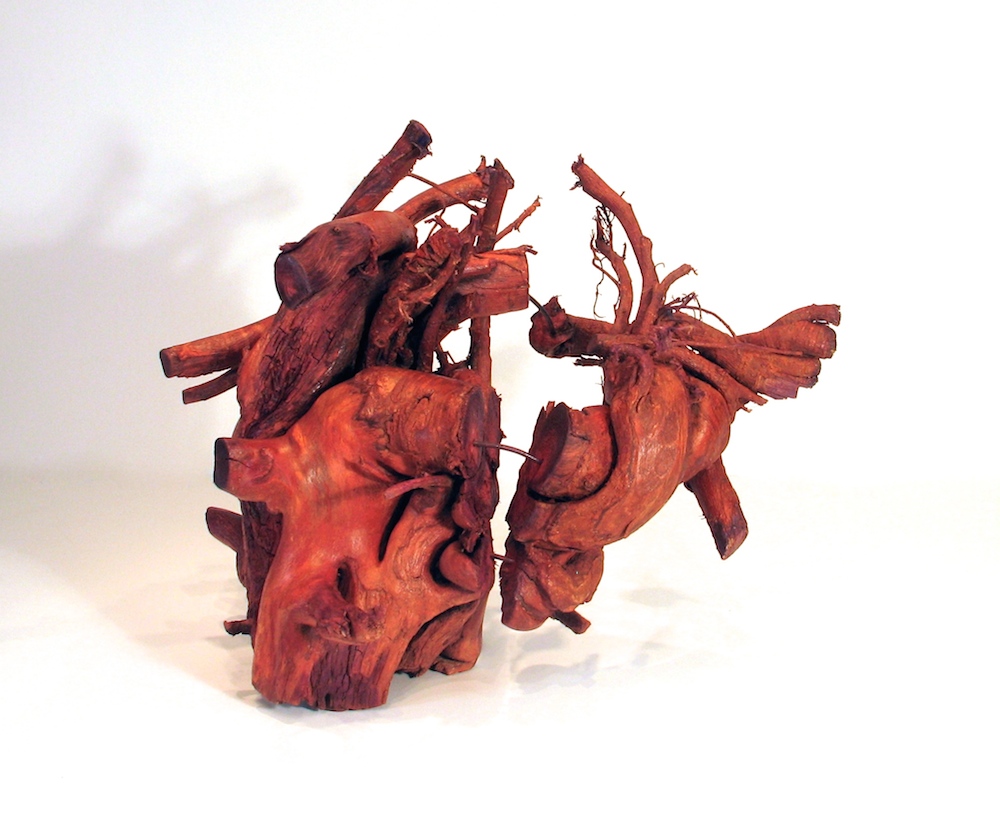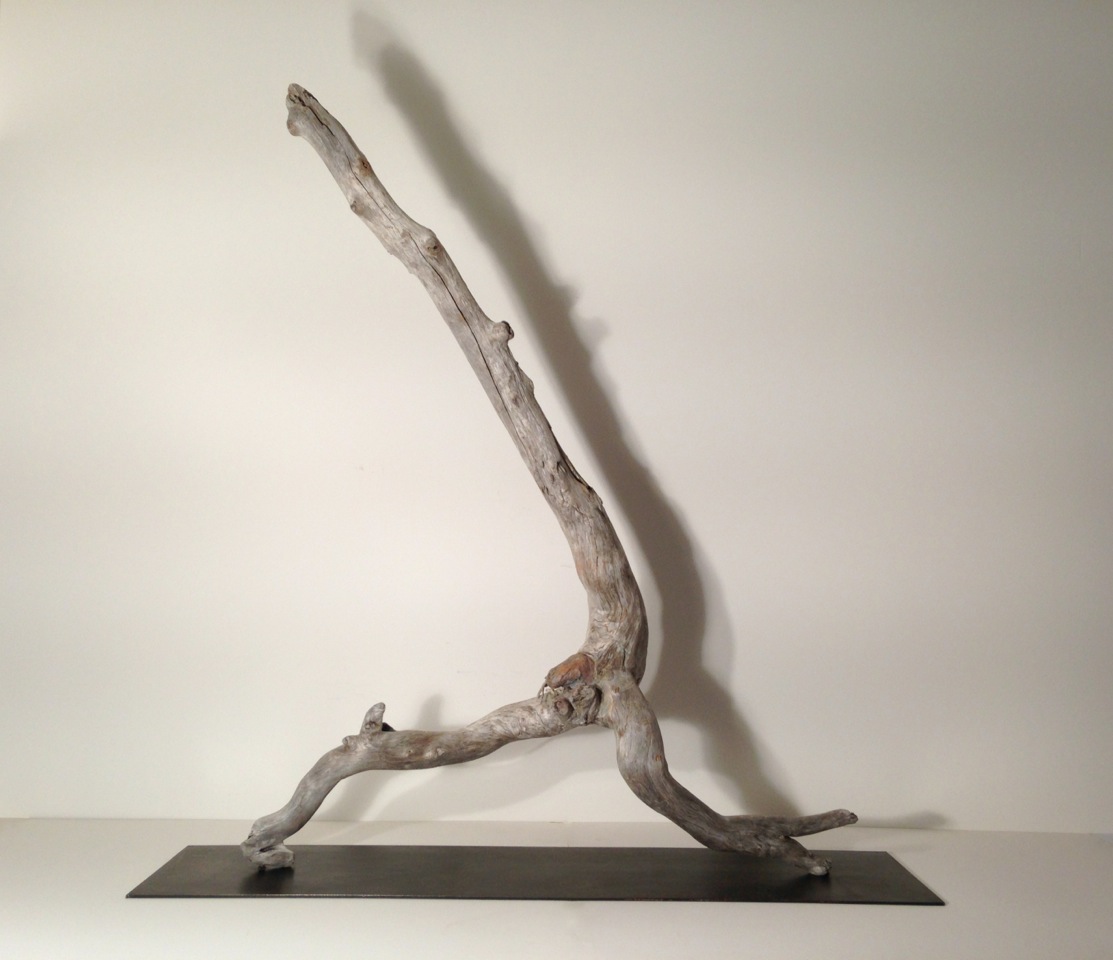AT THE ROOT
MARCH 4 TO MARCH 28, 2015
Menacing Attraction
Judith A. Mason
I must admit, when Sally took me down to her studio to show me her new work for this exhibition I was taken aback by its darkness, bleakness and bare bones vulnerability. In the empty spaces of this new work I felt a presence - threatening, all encompassing and almost unbearable – things gone wrong, parts missing, a pairing down, an emptying, repeated deaths, immense mourning, disturbing apparitions.
Root systems, dug out from under the earth, exposed, then beautifully cut and coloured to highlight their dead sculptural form. A powerful black beetle-like form (a shaman?) stands erect with an insect’s head threatening to take us into dark and unknown territories. A hanging red spider with a child’s tea service hovers nearby, suggesting the strange and hallucinatory world of Alice in Wonderland. A disturbing assemblage of fragmented parts form a disjointed sexualized female body, breasts exposed, with a birdhouse as its head. It is this juxtaposition of materials, processes and ideas that makes Thurlow’s sculptural assemblages compelling. Her constructions evoke a desire to control, to keep them under wraps at all costs.
At the Root continues Thurlow’s investigation of environmental and feminist issues. What I find most interesting in this work, however, is not the critique of environmentalism or the subversive tenets of feminism but the considered way Thurlow constructs her forms and their fascinating relationship to Freud’s notion of the “uncanny.”
In her book, Speaking Desires can be Dangerous (i), psychoanalyst Elizabeth Wright writes, “The concept of the uncanny has become important in postmodern aesthetics because it acts as a challenge to representation. It makes us see the world not as ready-made for description, depiction or portrayal (common terms applied to what an artist or writer does), but as in a constant process of construction, deconstruction and reconstruction.” (ii) Thurlow is repeatedly enacting this process. Whether by deconstructing and reconstructing a previous work (Systems Failure, 2002) or gathering and manipulating found materials, she creates in this series a return of the repressed, the feared desire-fantasy of the uncanny.
Theodor Adorno writing about Surrealism, suggests that the uncanny effect is brought about because we are confronted with “a subjectivity now alien to us, having had to move on.” He maintains that images of our childhood is “a past crystallized within us” (iii) are triggered into consciousness by images in art.
An intensity of experience is embedded throughout Thurlow’s work that reminds me of the intense feelings of childhood. Her work has an affinity with Surrealism. In Surrealism “art objects are most carefully chosen and placed, in just this space next to another object just this size.” (iv) In Thurlow’s case her materials are carefully chosen and are not only placed nearby but are permanently attached (The Fascinator, 2015).
Wright suggests a strong subversive element in the idea of the uncanny. (v) It can be a sign that it is time to think about changing self and world. (vi) She writes, “The uncanny may thus be seen as a basis for a positive aesthetic, a moment when new possibilities, new meanings, may emerge, rather than as a moment when the old repressed meaning returns.” (vii) While At the Root stages this moment when new possibilities, new meanings may emerge, it never quite relinquishes the other possibility - of immanent threat, fear and death.
i. Elizabeth Wright, Speaking Desires can be Dangerous (Polity Press in association with Blackwell Publishers Ltd., 1999). Wright analyses the relationship between art (specifically literature) and psychoanalysis. Her book’s title has two meanings – to speak our desires is dangerous and the desires that are speaking are dangerous. Both meanings can equally be applied to Thurlow’s work. ii-vii Ibid p. 19-24
Sally Thurlow: Sculptor
Margaret Rodgers
Thurlow creates her robust, gendered sculpture not only from the flotsam that washes up from the ocean and that big lake that so defines our sense of geography in Southern Ontario, but metaphorically from a life in this time and place.
Two major exhibitions previous to this show dealt with ideas surrounding water, shorelines, and the wide range of conceptual territory that can be covered through related mediums. From 1999-2005 the artist created a series of canoe forms, using various materials such as driftwood, metal, fabric, even split transport truck tires. Each piece held a particular meaning that connected to her thoughts on environmental and cultural issues. Then came the cast of characters derived from driftwood shapes, and a transition from the creation of specific structures (i.e. canoes) toward the "reading" of existing form occurred. At the Root effectively synthesizes the form and content from the earlier projects while moving into fresh territory.
The artist's initial training in clothing and fabric design has served her well in terms of the high degree of craftsmanship that allows her to realize her ideas with panache. For instance, in an ode to Cathy Daly, she creates a black wire dress, quite elegant on its own and supported by an armature of salvaged wood from a de-barked and tunnelled tree limb. The figure is enshrouded with a carapace cape and mask of a tree beetle, this in graceful connection to a human-animal continuum, and underscoring Thurlow's feelings of responsibility toward the natural world.
This creation, while containing echoes of past work, moves off from more austere pieces such as the Black Madonna and Agony, that featured polished and stained tree roots exhibited at eye level on steel plinths. The historical and spiritual connotations that emerge via the titles are in stark contrast to this year's funky colourful Fascinator.
Consisting of tree limbs, a red birdhouse, torn fishnet stockings, and even a bird's nest, she is a tarted up version of the earlier monochromatic figures. Referring to her as "a complicated goddess" Thurlow links attitudes toward women to the way that nature is regarded, "how we use and abuse it, how we think of it as brain-less, but then attribute all the negative things we can say when 'Mother Nature' blows her stack in reaction to our greedy climate-changing behaviours..." (artist quote.) Coming from an ecofeminist point of view, the work is saved from the polemical by a whimsical dark humour and superb attention to detail.
Thurlow often mentions her interest in creating art that can function at multiple ranges of viewing, a quality that is evident once again in this new series.






